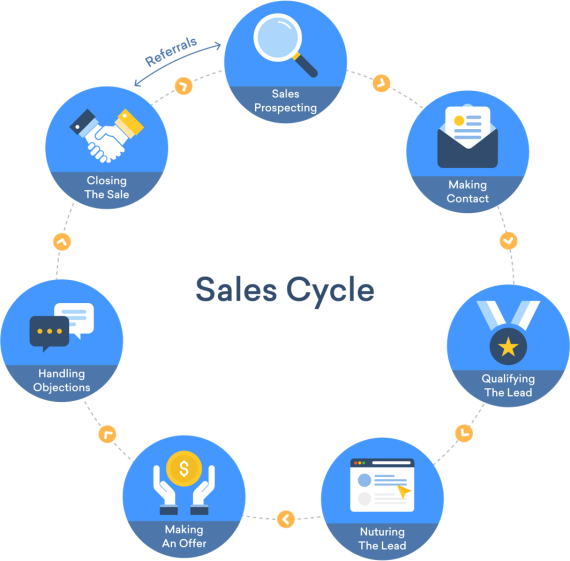Understanding Sales Pipeline
A sales pipeline can be defined as a visual snapshot of where prospects are in the sales process. A typical sales pipeline has a set of stages that a prospect moves through, as they progress from a new lead to a customer.
Think of the sales pipeline as digital sales management for all your sales opportunities.
To understand the true meaning of sales pipeline, let's break that definition down and look at the parts:
- Visual snapshot - Pipelines provide a snapshot of the different stages that comprise a company’s sales cycle or process. Also, the pipeline visualizes each phase of the sales process, understands them, and spot weak links in the chain of events that lead toward a sale.
- Prospects - These are the potential customers who have an interest in the company’s products.
- Sales process - This is a structured, step-by-step formula that tells the company’s reps exactly what activities they need to do to close a deal. It acts as a guide for sales reps to move a deal through the sales pipeline and close it.
Sales Pipeline Stages

Sales pipeline stages correspond to the steps a business takes throughout the sales process. But the number and type of stages in your pipeline may vary from company to company. Regardless of what industry your company belongs to, your sales team has to move through a few well-defined stages.
The following are some of the stages common to most sales pipelines:
Lead Generation Stage
The Lead Generation stage is the beginning of your sales pipeline. During this stage, you’re eager to get new leads however these leads don’t know a lot about your company. They may be extremely reluctant to put down their hard-earned money on your products or services this early. For this stage, your main goal is to gather as many leads as possible. Here are some lead generation tactics:
- Attend trade shows and meet your potential prospects in person
- Create winning content every week and then promote it
- Pay for advertisements on websites and social media
- Cold calls or warm calls with leads
- Meet with prospects and network
Lead Qualification Stage
Now that you have completed the first stage, you should have a healthy stream of leads. The Lead Qualification stage is all about identifying which leads are worth pursuing based on the likelihood of them making a purchase. Not all the leads that express their interest end up buying the product hence the leads with a low probability of conversion eventually fail to go to the next stage of the pipeline. On the other hand, leads that express an interest in your product are called qualified leads, and they are moved to the next stage. This lead qualification stage allows the sales team to focus their efforts on leads that are more likely to convert.
First Contact Stage
Now that you’ve qualified your leads, initial contact with them has to be made. The first contact can be made via phone calls, meetings, or emails depending on the sales process of your business. This is the first meeting with the lead, so the way you prepare for it matters a lot. It’s a good idea to plan ahead as much as possible, try to keep all the information about the prospect in front of you, write down questions and topics you want to discuss. Here are some questions which you need to clearly answer before the first contact with your lead:
- What are your goals with this meeting?
- Are you trying to inform them more about your company’s products or services?
- Do you want to make the sale right then and there?
Offer Stage
By this point, you’ve learned a ton about your prospect, their pain points, and their needs. Thus, you’ve assessed whether your products or services are the right fit for the lead. Now, you can finally make your offer depending on the prospect’s needs. For some prospects, you might try a free trial but the user would have to put money towards an upgrade of the product. You could give prospects a week or a month to use the product, and then if they want to use it further, they’d have to buy it. In this stage, you must acknowledge that you understand the needs and problems of your prospects, and then you have to position your product or service as the solution to those problems.
Win/Loss Stage
When you make your offer to the prospect, they will either say yes or they’ll say they’re not interested. If the prospect said yes, then you can move on to the final stage in the sales pipeline. If the prospect said no, then this might be the last stage. You can always try to change the mind of a prospect, but being forceful will never garner you repeat business. With time, you can reach out to them again and see if their needs have changed. For now, as hard as it is, you have to count this for a loss.
Closing Stage
This is the stage where terms may be negotiated and formal contracts are often drawn up. If prospects have questions or concerns, you want to do your best to answer and address these right away, so they feel confident striking a deal with you. Next, you can cover the terms of your deal, then present a contract for them to sign. Once the contract is signed, it is essential to start immediate onboarding and delivery to ensure maximum customer satisfaction. Remember, a loyal customer base can be a great touchpoint for upselling or cross-selling your products and services.
Tags



How We Doing Here